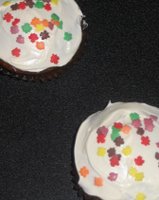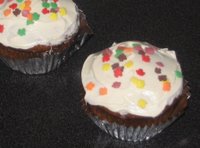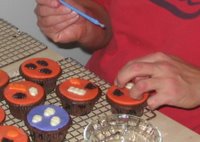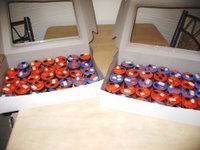I must say I was a little surprised to get this for my birthday. I've always wanted one but it really is such a want versus a need that I could never convince the miser in me to buy one. I would see the posts on other's blogs about the various sorbets and gelatos and ice creams and then I'd float over to Amazon to view the various options but that's where the fantasy ended. Or so I thought. Lorrie knew I wanted one and it isn't beyond reason that she would get me one. It's just she had been talking that my birthday gift was going to be a tattoo...for her. She wanted to get a tattoo similar to the raven on my shoulder. I thought that would be a pretty nice gift too.
Just as soon as the freezer bowl found a home among the frozen fish fillets and bags of icy fruit, I hit the cookbooks for recipes. I didn't need to go any further than the included recipe pamphlet to find what I needed to fulfill my promise to Lorrie: pistachio ice cream. Very simple to make and very easy to eat! This was so creamy, coat-your-tongue creamy. Just look at the ingredients and you can see why - three cups of heavy cream. Wonderful flavor and I was a bit surprised by that. When I added the extracts (and I didn't measure exactly like it asked but pretty close) I thought the flavors where a bit strong to taste. My concerns of this having the extract-y taste were for naught. Once frozen and mixed with the nuts, the vanilla and almond flavors were mild and only highlighted the pistachios.
Speaking of the pistachios, I couldn't find any unsalted or lightly salted. So I went ahead with the full salt ones anyway. It ultimately added a slight taste of salt, which I think made it better. I think the bigger issue was it lowered the freezing point of the cream mixture and it never really froze hard. I'm not sure I would use unsalted pistachios if I had access to them because Lorrie and I absolutely loved this ice cream as it was and I'm not sure unsalted pistachios would improve the flavor.
Before I started making anything, I consulted Kate Zuckerman's book The Sweet Life: Desserts from Chanterelle. Chapter six is called Ice Creams, Sorbets, and Frozen Desserts, and she starts this chapter with guidelines for making frozen desserts. Kate gives an introduction to the science behind ice cream making and then relates her experiences making ice cream in restaurant kitchens and at home. The key is controlling ice crystal formation and she explains how the ingredients, preparation, and even the machines can affect your end product.
Pistachio Ice Cream
from page 5 of the Cuisinart Pure Indulgence Ice Cream Maker Recipe Booklet
Makes about 2 quarts or so
1 1/3 cups whole milk, well chilled
1 1/8 cup granulated sugar
3 cups heavy cream, well chilled
1 1/2 teaspoons pure vanilla extract
1 tsp. pure almond extract
1 1/2 cups shelled pistachios, roughly chopped (use plain or lightly salted and don't use red)
Combine the whole milk and sugar in a mixing bowl and mix by hand or with a mixer on low speed until the sugar has dissolved. Stir in the heavy cream and the two extracts.
Set-up the machine and turn it on. Pour the mixture slowly into the bowl and churn until thickened. When it is close to being the desired thickness, add the pistachios. Once done, use right away or freeze for up to 12 hours to let it set. Use within a day or two.















 Lebkuchen
Lebkuchen









 We had some baker's boxes to put them in and lined the bottoms with Halloween themed paper from the scrapbooking section of
We had some baker's boxes to put them in and lined the bottoms with Halloween themed paper from the scrapbooking section of 
